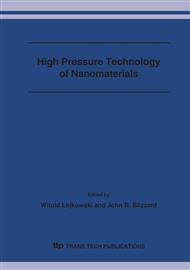p.251
p.257
p.265
p.271
p.277
p.285
p.291
p.297
p.303
Nanotube and Nanorod Synthesis under High Frequency Electric Discharge Assisted Mechanical Milling
Abstract:
Electric discharge assisted mechanical milling using a 50 Hz power supply has been used to produce a range of fine and nanostructural products, including nanocrystalline aglomerates and individual nano-particles and nano-fragments. Processing variables include; starting powder sample size; electric arc parameters such as arc length and arc voltage/current; mechanical milling parameters; gas atmosphere and ionized gas species present. We describe results of an experimental program underway to investigate phase transformations and/or particle fragmentation during discharge milling using a new pulsed power supply working at frequencies in the kHz range. The aims of this preliminary investigation were to determine processing parameters required for the synthesis of potentially useful high surface area particles, nanostructural powders and nanoparticles, and to compare products with those synthesised by Hz frequency discharge milling. Microstructural, morphological, and phase changes induced by kHz discharge milling were characterised by x-ray diffractommetry and transmission electron microscopy. Results were found to depend on the often competing processes of fragmentation into nano-particles, agglomeration of powder particles, particle melting and/or sintering, and chemical reaction induced by mechanoprocessing in the presence of a particular type of plasma. Discharge milling of graphite under Ar/4%H2 resulted in a range of products including; graphite nanostructures, carbon nanotubes and other exotic nanofragments. It was found that, compared with processing at 50 Hz, high frequency (kHz) electric discharge assisted mechanical milling of graphite resulted in higher yields of carbon nanotubes. hematite resulted in partial reduction to magnetite and FeO,and the formation of nanostructural oxide nanorods and nanorod clusters. Discharge milling of Co-WC resulted in products including; micron and submicron fracture products, nanostructural regions of Co and WC, and carbon rich nanorods and nanotubes.
Info:
Periodical:
Pages:
277-284
Citation:
Online since:
July 2006
Authors:
Price:
Сopyright:
© 2006 Trans Tech Publications Ltd. All Rights Reserved
Share:
Citation:


